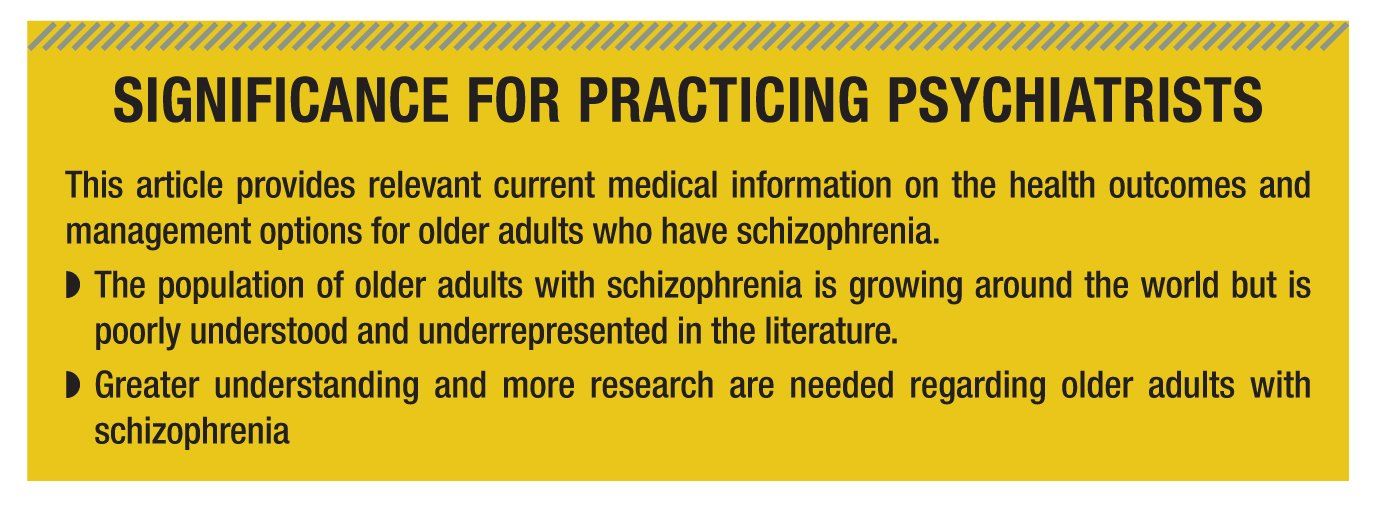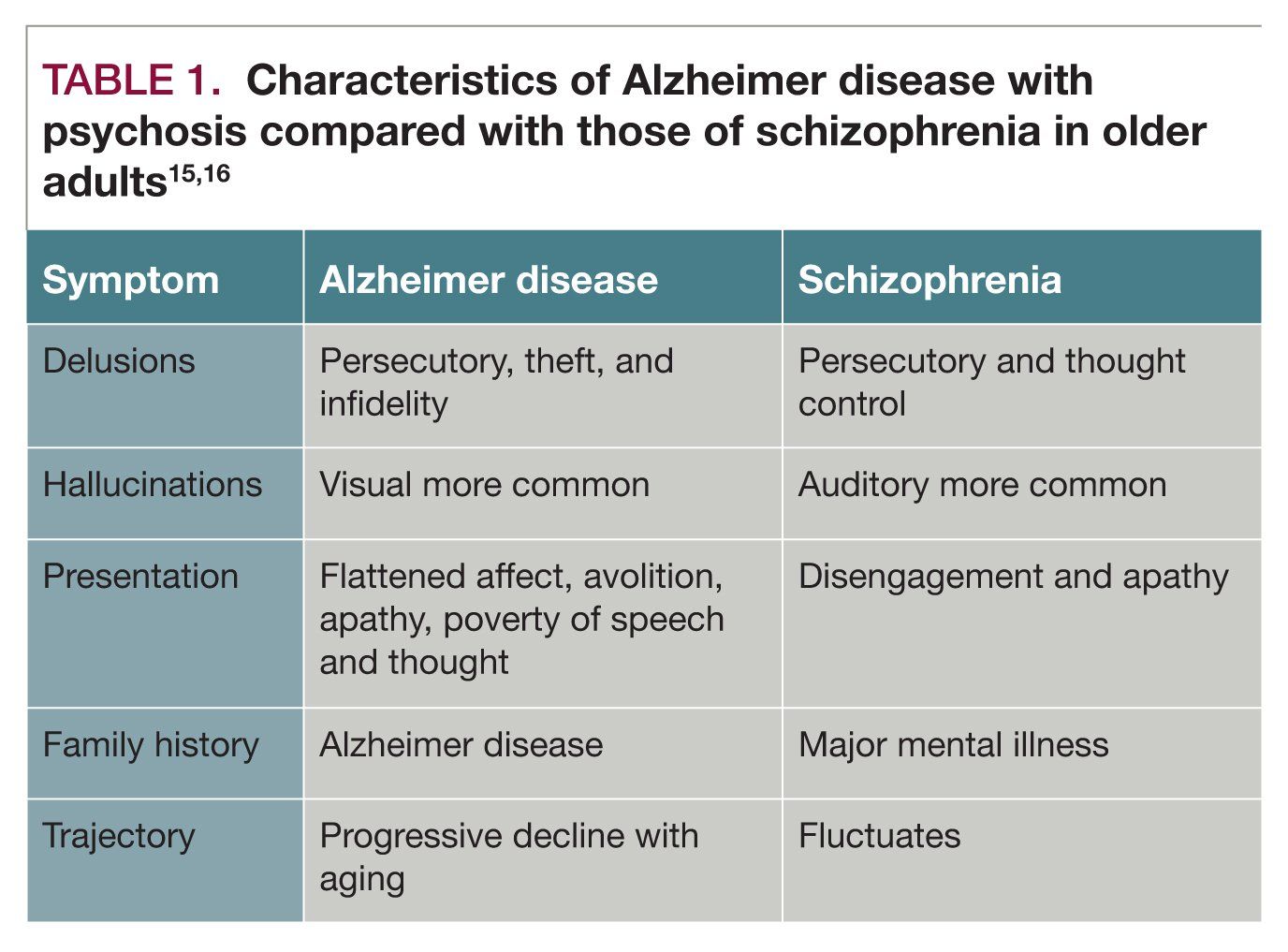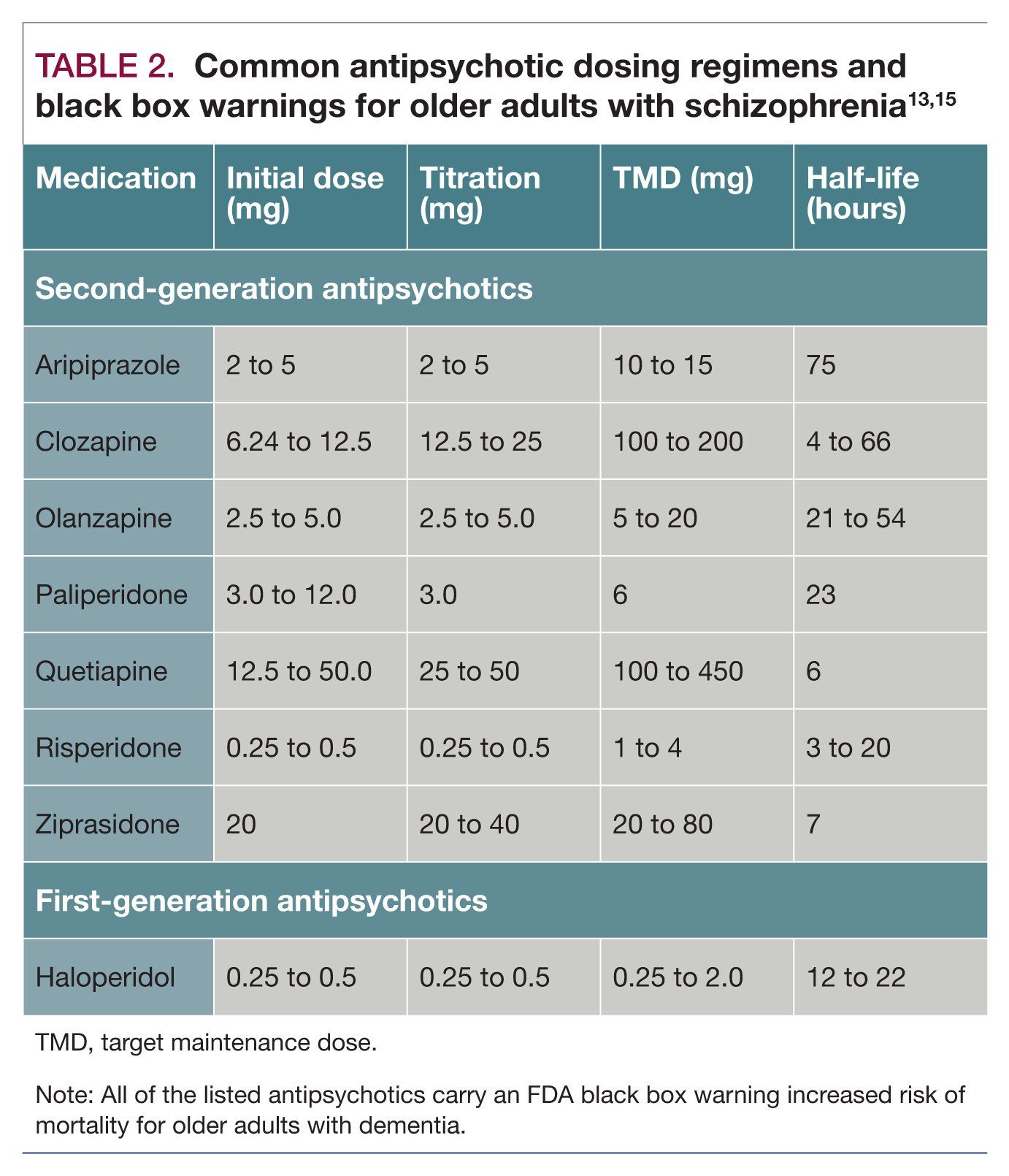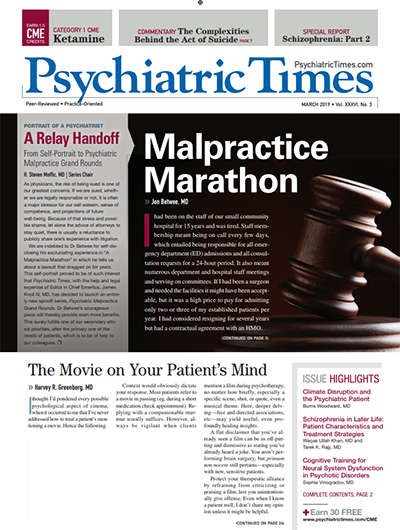Publication
Article
Psychiatric Times
Schizophrenia in Later Life: Patient Characteristics and Treatment Strategies
Author(s):
With the prevalence of schizophrenia in older adults set to double and reach 1.1 million people in the US by 2025, greater attention to research and policy regarding this population is needed.
magann@stock.adobe.com

SIGNIFICANCE FOR PRACTICING PSYCHIATRISTS

TABLE 1. Characteristics of Alzheimer disease with psychosis compared with those of schizophrenia in older adults

TABLE 2. Common antipsychotic dosing regimens and black box warnings for older adults with schizophrenia

A global health crisis is emerging because of the changing demographics and care of older adults with schizophrenia. Individuals aged 55 years and older will soon account for 25% or more of the total population of patients with schizophrenia worldwide.1 Among persons aged 60 years and older with mental and substance-use disorders, schizophrenia ranks third in causes of disability-adjusted life-years.2 Older adults with schizophrenia also have a substantial impact on health care costs, with an estimated greater expenditure per person compared with most other medical and psychiatric disorders.
Research on older patients with schizophrenia has been neglected; roughly 1% of the schizophrenia literature focuses on this population.2 With the prevalence of schizophrenia in older adults set to double and reach 1.1 million people in the US by 2025 and 10 million worldwide by 2050, greater attention to research and policy regarding this population is needed.
Morbidity and mortality
Older patients with schizophrenia include individuals with an early-onset that persists into later life and those with a late onset of this condition. There are currently two generations of older adults with schizophrenia: the “old-old” (those 75 years and older) and “young-old” (aged 55 to 74 years).2 Although more adults with schizophrenia are living longer, their life expectancy is still shorter than that of unaffected individuals. The risk of mortality is two to three times greater in patients with schizophrenia than in the general population, and this gap has been increasing over the past decades.2 In older adults with schizophrenia, the mortality rate and deaths caused by suicide and accidents are higher than in healthy peers.
Older persons with schizophrenia also have higher rates of congestive heart failure, chronic obstructive pulmonary disease, and hypothyroidism than unaffected peers. This is partially due to lifestyle factors such as poor diet, smoking, and physical inactivity as well as antipsychotic drug effects. Given the limited knowledge of the mechanisms underlying the increased morbidity and mortality in elderly patients with schizophrenia, further research is needed to identify modifiable clinical and social risk factors.
Positive and negative symptoms
It has been commonly understood that positive symptoms of schizophrenia decline in later life, while negative symptoms dominate the presentation in older age. However, findings from several studies have invalidated this notion. The International Study of Schizophrenia (ISoS) assessed 18 global cohorts over 15- and 25-year periods and found 77% of patients had no evidence of significant negative symptoms over the course of their illness.3 Similarly, a longitudinal study of institutionalized geriatric patients with schizophrenia showed no significant changes in negative symptoms over time.4 From a clinical perspective, negative symptoms do not dominate in older adults with schizophrenia and are often expressed in a similar magnitude seen in younger patients.
Cognition
Cognitive deficits are a fundamental feature of schizophrenia; they are observed across the life span of affected individuals and are among the strongest predictors of functional disability. Functional disability accounts for roughly half of schizophrenia treatment costs, which increase substantially later in life. Older adults with schizophrenia have significant cognitive deficits in executive functioning, speed of processing, attention/vigilance, working memory, verbal learning, visual learning, reasoning, and problem-solving.
Research has shown a heterogeneity in the trajectory of cognitive function in older patients with schizophrenia based on residential status.5,6 Cognitive decline in community-dwelling patients with schizophrenia is similar to that in unaffected individuals until the age of 65 to 70 years. After 70 years of age, an accelerated cognitive decline in older adults with schizophrenia cannot be ruled out. Cognitive decline is also greater in older adults with schizophrenia who had long periods of institutionalization, especially those over 65 years of age.5
In a longitudinal study, three cognitive function trajectories in patients with schizophrenia were identified. They included stable cognition observed in 50% of the cohort, a slight decline in 40%, and a rapid decline in 10%. The course of cognitive decline for healthy peers is similar to the stable schizophrenia group.7
Because most studies found no significant decline in cognitive function in older patients with schizophrenia compared with their healthy peers, it is believed that schizophrenia is a syndrome of premature aging. Preserving and improving cognitive function in older adults with schizophrenia are thus important objectives with significant individual and public health benefits.
Dementia
Differentiating between schizophrenia and Alzheimer disease with psychosis in older adults can be difficult, but there are distinguishing features (Table 1). The prevalence of dementia in older adults with schizophrenia is expected to increase significantly. Older individuals with schizophrenia have a two-fold increased risk of developing dementia before the age of 80 years when compared with the general population. Several factors associated with the increased risk of dementia include age, low educational attainment, premorbid cognitive dysfunction, cardiovascular disease, polypharmacy, and a history of alcohol and/or substance abuse.
The etiology of dementia in older adults with schizophrenia remains unknown. However, long-term exposure to a high anticholinergic burden is associated with cognitive deficits in individuals with and without schizophrenia. It is interesting to note that older adults with schizophrenia and a high anticholinergic burden have a cognitive impairment profile consistent with that observed in Alzheimer dementia.
The Anticholinergic Cognitive Burden scale is a useful tool to identify patients at risk for anticholinergic-related cognitive impairment.8 In older adults with schizophrenia, the anticholinergic burden should be assessed before additional medication is prescribed.
Insight
A common feature in schizophrenia is impaired insight-more than 50% of individuals have moderate to severe deficits.9 Impaired insight significantly affects health outcomes by reducing patients’ awareness of their mental disorder, its symptoms and implications, and treatment adherence. In a review that examined the effects of aging on insight into illness in adults with schizophrenia, impaired insight followed a U-shaped trajectory.10 More specifically, insight is severely impaired during the first episode of psychosis, modestly improves during midlife, and declines again in later life. The association between impaired insight and illness severity, as well as cognition, is stronger in older adults with schizophrenia than in younger patients. Noninvasive neurostimulation techniques, cognitive-enhancing medications, and early intervention to improve insight into illness should be considered for older individuals with schizophrenia.
Pharmacotherapy
Older adults are more susceptible than younger individuals to the adverse effects of antipsychotics. This is because of age-related pharmacokinetic changes that increase the distributed volume and elimination half-life of antipsychotic drugs, changes in the permeability of the blood-brain barrier that increase drug availability in the brain, and pharmacodynamic changes that decrease the absolute number of dopaminergic neurons and D2 receptor density in the brain. In older adults with schizophrenia, extrapyramidal symptoms occur at lower D2 receptor occupancies than in younger patients. Older age is also a risk factor for antipsychotic adverse effects such as parkinsonism, tardive dyskinesia, falls, and metabolic syndrome. These drug effects can further impair cognitive and functional capacity in older patients with schizophrenia.
Despite the limited research and challenges in using antipsychotics to treat older adults with schizophrenia, these drugs are effective in controlling psychotic symptoms. Olanzapine and risperidone are efficacious in treating older patients with non-resistant schizophrenia. We recommend risperidone as the first-line treatment in this population because olanzapine has a high anticholinergic burden. Other second-generation antipsychotics with a low anticholinergic burden should also be considered, such as aripiprazole and ziprasidone.
Because of the risk of agranulocytosis, few studies have examined the efficacy of clozapine in older patients with treatment-resistant schizophrenia. Nevertheless, we believe it is worth considering over other anti- psychotic medications that have an equally high anticholinergic burden, such as olanzapine.
In view of their adverse effects, antipsychotic drugs should be prescribed with care and at the lowest therapeutic dose. Table 2 lists anti- psychotic dosing regimens for older adults with schizophrenia. A helpful method to determine the appropriate dosage and minimize adverse effects is to measure a patient’s serum prolactin levels.
A longitudinal positron emission tomography study found the antipsychotic dosage can be successfully reduced in over 80% of patients with stable late-life schizophrenia.11 Moreover, a lower dosage led to fewer adverse effects and extrapyramidal symptoms, less hyperprolactinemia, and improved clinical symptoms through reduced D2/3 receptor occupancy.
A follow-up study found that reducing antipsychotic dosages by up to 40% increased D2 receptor availability in the striatum.12 This increase allows the striatum D2 receptors to contribute more significantly to cognitive function, and it can be targeted by interventions that promote cognitive enhancement in late-life schizophrenia.
The decision to start a second-generation antipsychotic in an elderly patient with dementia is not to be taken lightly. In April 2005, the FDA asked manufacturers of second-generation antipsychotics to include a “black box” warning in their label. Using clinical data, the FDA determined that elderly patients with dementia who were treated with second-generation antipsychotics for behavioral disorders had an increased risk of mortality. In June 2008, the FDA extended this warning to include first-generation antipsychotics.13
Nonpharmacologic psychosocial interventions
Nonpharmacologic interventions help reduce psychotic symptoms and augment pharmacotherapy. Cognitive remediation is a behavioral intervention developed to improve cognitive deficits by repeated task practice and/or strategy acquisition. Although patients with early-stage and early-chronic schizophrenia have greater improvement in their working memory after receiving cognitive remediation than older patients, adaptations in existing programs can address the cognitive needs of older individuals.
Cognitive-behavioral therapy is another nonpharmacologic intervention widely used to resolve problems with social relatedness, positive and negative symptoms, and mood in older adults with schizophrenia. Social skills therapy has also been used in this population to treat difficulties with social interaction, while exercise programs help reduce declines in cognition and activities of daily living. The use of mobile devices to facilitate these psychosocial interventions can improve the dissemination of psychosocial interventions in the community setting.
Neurostimulation
Given the adverse effects of antipsychotic drugs in older adults with schizophrenia, alternative treatments are needed. Brain stimulation in the form of electroconvulsive therapy, transcranial magnetic stimulation, and deep brain stimulation offer viable solutions, especially in the context of medication resistance. Bilateral electroconvulsive therapy has been effective for both acute and maintenance treatment of older adults with early-onset schizophrenia, but not for older patients with late-onset schizophrenia. A pilot study of magnetic seizure therapy in patients with treatment-resistant schizophrenia showed significant clinical and quality-of-life improvement, but more trials with larger cohorts are needed.14 Unfortunately, transcranial magnetic stimulation and deep brain stimulation have not been evaluated in older adults with schizophrenia.
Conclusion
The current knowledge of schizophrenia in older adults reveals a different state of health compared with younger affected individuals. More research to understand the neurology underlying its clinical features, along with the development of novel age-appropriate services and treatments to improve impairments in older adults with schizophrenia, should be prioritized.
Disclosures:
Dr Khan is Research Fellow, Centre for Addiction and Mental Health (CAMH), and Campbell Family Research Institute, and Department of Psychiatry, University of Toronto, Ontario, Canada; Dr Rajji is Deputy Physician-in-Chief, Clinical Research, and Chief, Adult Neurodevelopment and Geriatric Psychiatry, CAMH, and Campbell Family Research Institute. He is also Canada Research Chair, Neurostimulation for Cognitive Disorders, and Associate Professor of Psychiatry, University of Toronto. The authors report no conflicts of interest concerning the subject matter of this article.
References:
1. Cohen CI, Vahia I, Reyes P, et al. Focus on geriatric psychiatry: schizophrenia in later life: clinical symptoms and social well-being. Psychiatr Serv. 2008;59:232-234.
2. Cohen CI, Meesters PD, Zhao J. New perspectives on schizophrenia in later life: implications for treatment, policy, and research. Lancet Psychiatry. 2015;2:340-350.
3. Harrison G, Hopper K, Craig T, et al. Recovery from psychotic illness: a 15- and 25-year international follow-up study. Br J Psychiatry. 2001;178:506-517.
4. Putnam KM, Harvey PD. Cognitive impairment and enduring negative symptoms: a comparative study of geriatric and nongeriatric schizophrenia patients. Schizophr Bull. 2000;26:867-878.
5. Rajji TK, Mulsant BH. Nature and course of cognitive function in late-life schizophrenia: a systematic review. Schizophr Res. 2008;102:122-140.
6. Rajji TK, Voineskos AN, Butters MA, et al. Cognitive performance of individuals with schizophrenia across seven decades: a study using the MATRICS consensus cognitive battery. Am J Geriatr Psychiatry. 2013;21:108-118.
7. Thompson WK, Savla GN, Vahia IV, et al. Characterizing trajectories of cognitive functioning in older adults with schizophrenia: does method matter? Schizophr Res. 2013;143:90-96.
8. Tsoutsoulas C, Mulsant BH, Kumar S, et al. Anticholinergic burden and cognition in older patients with schizophrenia. J Clin Psychiatry. 2017;78:e1284-e1290.
9. Gerretsen P, Voineskos AN, Graff-Guerrero A, et al. Insight into illness and cognition in schizophrenia in earlier and later life. J Clin Psychiatry. 2017;78:e390-e397.
10. Gerretsen P, Plitman E, Rajji TK, et al. The effects of aging on insight into illness in schizophrenia: a review. Int J Geriatr Psychiatry. 2014;29:1145-1161.
11. Graff-Guerrero A, Rajji TK, Mulsant BH, et al. Evaluation of antipsychotic dose reduction in late-life schizophrenia: a prospective dopamine D2/3 receptor occupancy study. JAMA Psychiatry. 2015;72:927-934.
12. Rajji TK, Mulsant BH, Nakajima S, et al. Cognition and dopamine D2 receptor availability in the striatum in older patients with schizophrenia. Am J Geriatr Psychiatry. 2017;25:1-10.
13. Dorsey ER, Rabbani A, Gallagher SA, et al. Impact of FDA black box advisory on antipsychotic medication use. Arch Intern Med. 2010;170:96-103.
14. Tang VM, Blumberger DM, McClintock SM, et al. Magnetic seizure therapy in treatment-resistant schizophrenia: a pilot study. Front Psychiatry. 2017;8:310.
15. Rajji TK. Primary psychotic disorders in older adults. In: Rapoport M, ed. Geriatric Psychiatry Review and Exam Preparation Guide. Toronto, Ontario, Canada: University of Toronto Press; 2016:231-41.

Newsletter
Receive trusted psychiatric news, expert analysis, and clinical insights — subscribe today to support your practice and your patients.





